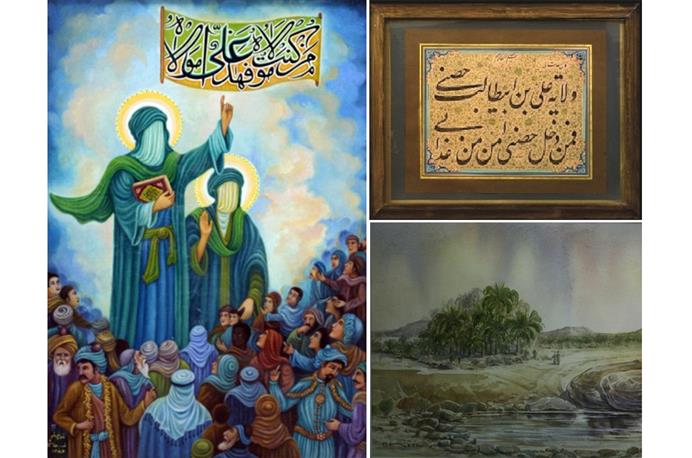Hawzah News Agency (Mashhad, Iran) - Speaking on the occasion of Willayat ten days, Javad Farahmand Nejad, head of Office of Research and Introducing Works at Astan Quds Razavi's museums, introduced existing works of the museums with the topic of Adha and Ghadir Eids and said, "A collection including relief decoration tableaus, mosaic replica, and oil-colored paintings have been put into display for all interested people in these days".
He referred to a tableau with the name of "Enormous Slaughter" offered by Reza Afshari and said,"This work has been created on canvas in 1390/ 2011using oil-colored technique; the size of this work is 110×110 cm".
Farahmand Nejad also referred to the painting of "Hazrat Ali's (a.s.) Willayat" created by Hossein Razzaqi in 1375/ 1996. He also mentioned that this work’s been created with acrylic technique on an acid-free paperboard and its size is 100×70 cm.
"Ghadir Khom Incident" tableau offered by Seyyed Fazlollah Hashemi in 1386/ 2007 and "Pond of Ghadir Khom" a work by Rasoul Shafaghati in 1389/ 2010 are two other works with the topic of Willayat displayed at Astan Quds Razavi's museums.
The first whose size is 70× 50cm was created using oil and color on the wooden board and the latter whose size is 50×30 cm was made by applying water color on acid-free paperboard.
Head of Office of Research and Introducing Works at Astan Quds Razavi's museums referred to other works with the same topic existing in other museums of Astan Quds Razavi as well.
He pointed to the wood-carved cane with the image of "Ghadir Khom" and stressed, "The length and diameter of this cane are 92 and 2.5 to 5 cm respectively and it was offered to the museum by Morteza Salim, an artist from Shiraz, in 1391/ 2012".
Regarding characteristics of this work, Farahmand Nejad said, "The image of Hazrat Muhammad (s.a.w.) when he takes Imam Ali's (a.s.) hand up has been carved at the top of the cane near its curved part. Image of people who are watching the incident and hearing "Willayat Tradition" can also be seen on the lower part of the cane. This form is extended to the lower part of the cane and image of some palm trees is seen at the lowest part of the cane".
He also referred to the book of Ali (a.s.) with a wooden cover page as another exquisite work including some parts of Hazrat Ali's (a.s.) traditions which was compiled by Ali Isa Abu Menhaj in four languages of Persian, English, Arabic, and French. This work was dedicated to the museum by Ali Mousavi from Lebanon in 1389/ 2010.
"Memorial Plate of Great Maneuver of Willayat" in 36×42 cm which was offered by Islamic Republic of Iran's ground force commander in 1375/ 1996 is another item in public display.
Calligraphy and painting tableau known as "Ali (a.s.)" written with Ma'la style of writing is another item among other works of this collection on which some explanations were given. This work has been created and offered by Majid Hossein Zadedh in 1384/ 2005.
It is worth mentioning that pilgrims and citizens interested in culture and art can visit this collection from Saturday to Wednesday since 8 a.m. up to 12:30 p.m. The center is also open on Thursdays since 8 to 11:30 a.m. and its services are rendered on Fridays since 8 to 12. Museum of Qur’an and Supreme Leader's gifts is located at Holy Shrine's Kousar Courtyard.

